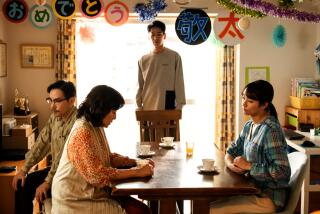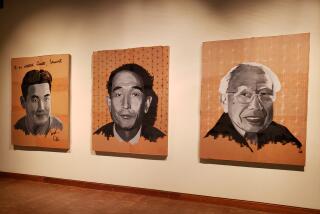STAGE REVIEW : Puppets Perform Chikamatsu Play at Japan America Theatre
- Share via
As the prosperity of postwar Japan began to corrupt traditional values, the Japanese rediscovered the long revered, but largely neglected love-suicide plays of Chikamatsu Monzaemon (1653-1725). These were poetic docudramas inspired by actual events--plays about young couples crushed by the money-grubbing realities of middle-class Osaka--and suddenly they again held nearly all their original relevance.
Revived in 1955 after a 250-year absence from the Bunraku puppet stage, Chikamatsu’s “The Love Suicides at Sonezaki” (1703) is now virtually the signature work of one of Japan’s most august performing institutions. It came to the Japan America Theatre on Wednesday on the first Bunraku visit to the United States in 15 years. And it is worth the wait.
Like “A Messenger of Love in Yamato,” a Grand Kabuki adaptation of Chikamatsu presented at the the theater in July, shows a society in which money could easily buy love and destroy friendship, a society leaving a young clerk and the courtesan he adores no way to be together except in death.
Enacted by figures designed at about three-quarters human scale, the three-act, two-hour production offers an extraordinary demonstration of collaborative artistry, as three-man teams work together to give each major puppet character not only an illusion of life but of tragic stature. In addition, there is the remarkable individual achievement of master puppeteer Minosuke Yoshida III, who brings astonishing tenderness to every tiny head tilt of the doomed teen-age courtesan.
Minosuke III finds great variety and poignancy in the gestural detail of the role: from the delicate way she lifts her sleeve to her face when weeping in the first scene to the grip of her hand on the bridge railing during her journey to death.
But there is more than merely fine puppet acting to the Bunraku experience, for though this is the youngest of the classic Japanese theater idioms, it is also the most strangely ritualistic.
This strangeness arises partly from the on-stage puppeteers who physically frame the action and who also seem to function as metaphors for destiny: Because the small, exquisitely proportioned “actors” in the play are relentlessly shadowed by giant figures in black who shape their movements and relationships, they invariably look overwhelmed by their circumstances. “How sad is this dream of a dream,” they cry, childlike victims with no illusion of free will or choice.
This sense of inevitability is reinforced by the deep, weighty singing of the narrator ( tayu ), an omniscient figure seated at the side of the stage, accompanied on the shamisen . He begins each act by holding high the text of the play as if it were some ancient doctrine.
The formality is intimidating: This is the truth teller, the sage interpreting disturbing current events--the unexpected death of a friend, perhaps--to the principles that underpin the society. We don’t understand the language, but the message is clear.
On Wednesday, the voice of Rodayu Toyotake V in the last two acts sounded weathered by time but still connected to some eternal source of energy. As he retold the story of the clerk and courtesan he became each of them and Chikamatsu, too--re-experiencing the emotions of the characters and also meditating on the play’s larger issues of trust, betrayal and sacrifice.
When the play itself grew more meditative and intimate in the last act, additional chanters and musicians accompanied the action, creating a large-scale lyric statement from the lovers’ laments. But even here Rodayu V remained central to the drama’s sound and sense, a link to traditions far older than Bunraku. If the puppets gave us an exotic and touching spectacle, Rodayu V showed us what theater itself was created to do.
Note: A synopsis of “The Love Suicides at Sonezaki” is included in the free house program, but the souvenir booklet contains a translation of the play by Donald Keene.
At 244 South San Pedro St., Little Tokyo, tonight at 8 p.m.; Saturday at 2 p.m. and 8 p.m., and Sunday at 2 p.m. Tickets: $30, $35; (213) 680-3700.
More to Read
The biggest entertainment stories
Get our big stories about Hollywood, film, television, music, arts, culture and more right in your inbox as soon as they publish.
You may occasionally receive promotional content from the Los Angeles Times.










